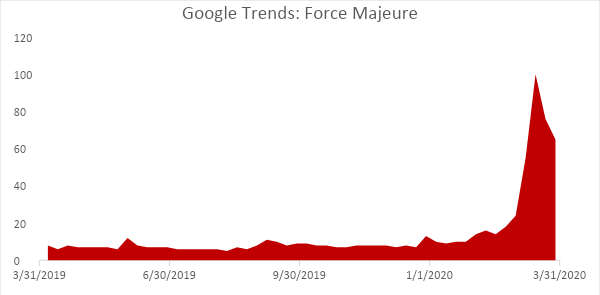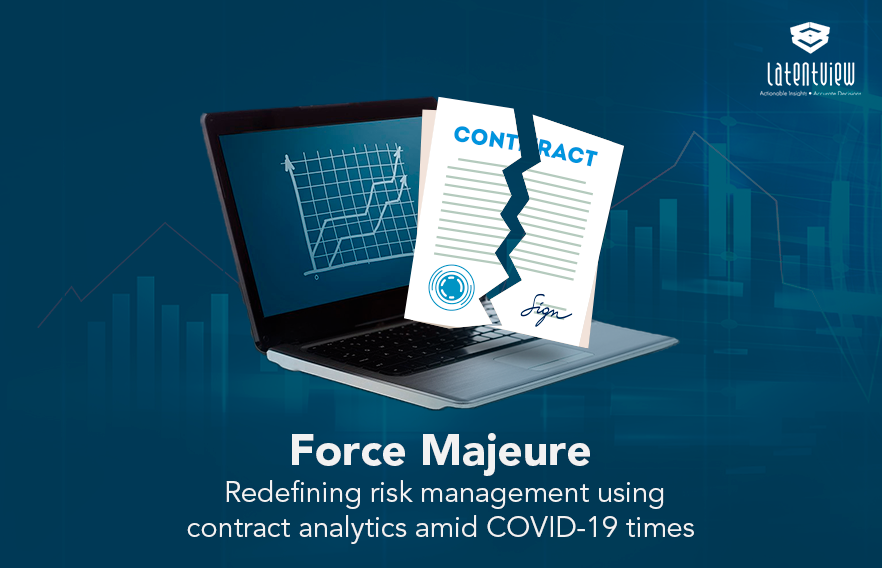When it comes to the world of contract management, organizations world over simply look at contracts as static documents and adopt a “sign and store” approach to it. Only when there is a disruption in service, contracts are fished out to re-read the fine print and understand clauses and its implications to the business. The current outbreak of COVID-19 is one such scenario that has pushed many companies to revisit their contract clauses to understand the associated obligations and risks. One clause that has become contentious in these times is the clause of Force Majeure in contracts.
During the Global Financial Crisis in 2008, the Force Majeure clause briefly rose to second place in the annual study of the most negotiated terms. Now with the COVID-19 crisis, once again Force Majeure is making its presence felt. The rise in the number of searches made in Google for this phrase confirms this.

Since the outbreak of COVID-19, there have been many instances of companies invoking Force Majeure in contracts. Suppliers in China alone have made more than 4,800 force majeure declarations, worth more than $50 bn, during the first few months of the COVID-19 crisis. With COVID-19 now being declared a global pandemic by the W.H.O., it is just a matter of time before companies across the globe start making such declarations. In these times, contract risk management has become very important.
The need for Force Majeure
Many organizations wish that they had better visibility into their contracts to handle this crisis. With thousands of contracts in place, manually reviewing and finding Force Majeure clauses is going to be a tedious task. Adding to the woes, with the reduced work-force due to lockdowns across various parts of the world, the task becomes even more difficult.
In these adverse situations, companies can make use of contract analytics, powered by ML techniques for Natural Language Processing(NLP), to search through myriads of documents, retrieve important information and find out the risk associated with each contract. This will significantly cut down the time and effort required by the Legal and Governance, Risk, Compliance (GRC) teams in getting answers to some of the key questions.
- How many contracts have provisions for force majeure clause in it?
- Who are the liable parties? (neither ones, both the parties or one of the parties)
- What steps does a party need to take to exercise these rights? (For example: giving prior notice within the stipulated time period to the other parties)
- What remedies does the force majeure clause provide concerning performance? (Termination of contract, excuse certain performances with contracts continuing, accepting delay till the event lasts, etc.)
- How can the set of contracts be prioritized in terms of risk associated?
Contract analytics for process efficiency
Contract analytics can also help identify other clauses such as Contingency and Extension Clauses, Insurance Clause, Indemnity clause, and Material Adverse Change Clauses and provide insights around these clauses to the GRC team. Combining the information extracted from contracts along with internal data sources (ERP, Finance and CRM systems) can help companies on several fronts like estimating the delay in servicing end customer, changes on the payments schedule, the cost associated with switching to new suppliers.
Use case: Leveraging contract analytics for increased accuracy
Our engagement with a Fortune 500 company on contract management helped them in turning their contracts from a static asset to a strategic asset. The client was engaging with multiple vendors across the globe for both direct and indirect procurement and managing contracts at a large scale was time-consuming and labor-intensive. Our offering on contract analytics benefited the client on several fronts and some of the key benefits were:
- Consolidated view of contract management
- Improved process efficiency
- Standardized approach replacing an existing manual approach which was error-prone
- Increased accuracy over 10%
To know more about how our NLP-based contract analytics helped in increasing process efficiency, click here.
In addition to the above-mentioned benefits, contract analytics can also offer the following benefits:
- Contract Risk Assessment which will help the client to identify risk associated with a vendor
- Companies can address revenue leakage effectively, provide greater customer experience and vendor management and superior compliance and risk management by integrating with Enterprise Systems such as ERP/CRM
In the upcoming months, the focus for the companies would be on the recovery. Converting the unstructured contract data into structured data provides insights into risk and obligation. These insights can help the business immensely to get back on its feet swiftly in the near term and strategically manage the crisis in the future. Additionally, these insights will help improve contract management systems.
LatentView Analytics would love to hear your thoughts on how contracts are managed, impact on your business due to the force majeure clause, and support you in managing risks and obligations. Do write to us at consulting@latentview.com or provide your comments below.



